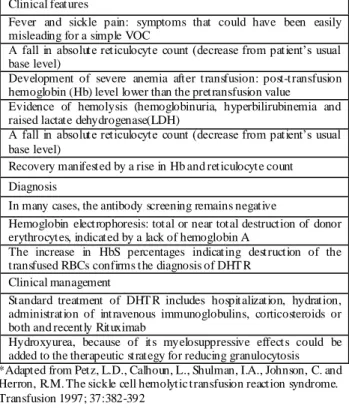Delayed Hemolytic Transfusion Reaction in Sickle Cell Disease
Texte intégral
Figure

Documents relatifs
There is an extensive literature on numerical schemes for the drift-diffusion equa- tions: finite difference methods, finite elements methods, mixed exponential fitting finite
As already underlined, any regular geodesic ball veri- fies the condition of Theorem 1.4.1; so we recover the well-known results of existence and uniqueness of a martingale
Arterial stiffness, known as an indicator for macrovascular function, has been analysed in sickle cell adults [11,12] but whether arterial hardening also occurs in children
Dans cette revue, nous détaillons l’implication du système du complément dans l’hémolyse ainsi que ses conséquences dans la drépanocytose et l’hémolyse
To determine the chromosomal background
In the current study we tested 102 SCA Tunisian children patients among whom 52 have cholelithiasis and 76 subjects were chosen as control group characterized with normal
Several pathophysiological pathways in sickle cell disease (SCD), the most prevalent hemoglobinopathy worldwide, result in activation of circulating blood cells and
Gray dots, hemoglobin level for patients with the postartesunate delayed-onset hemolysis (PADH) pattern of anemia; black dots, hemoglobin level for patients with non-PADH pattern